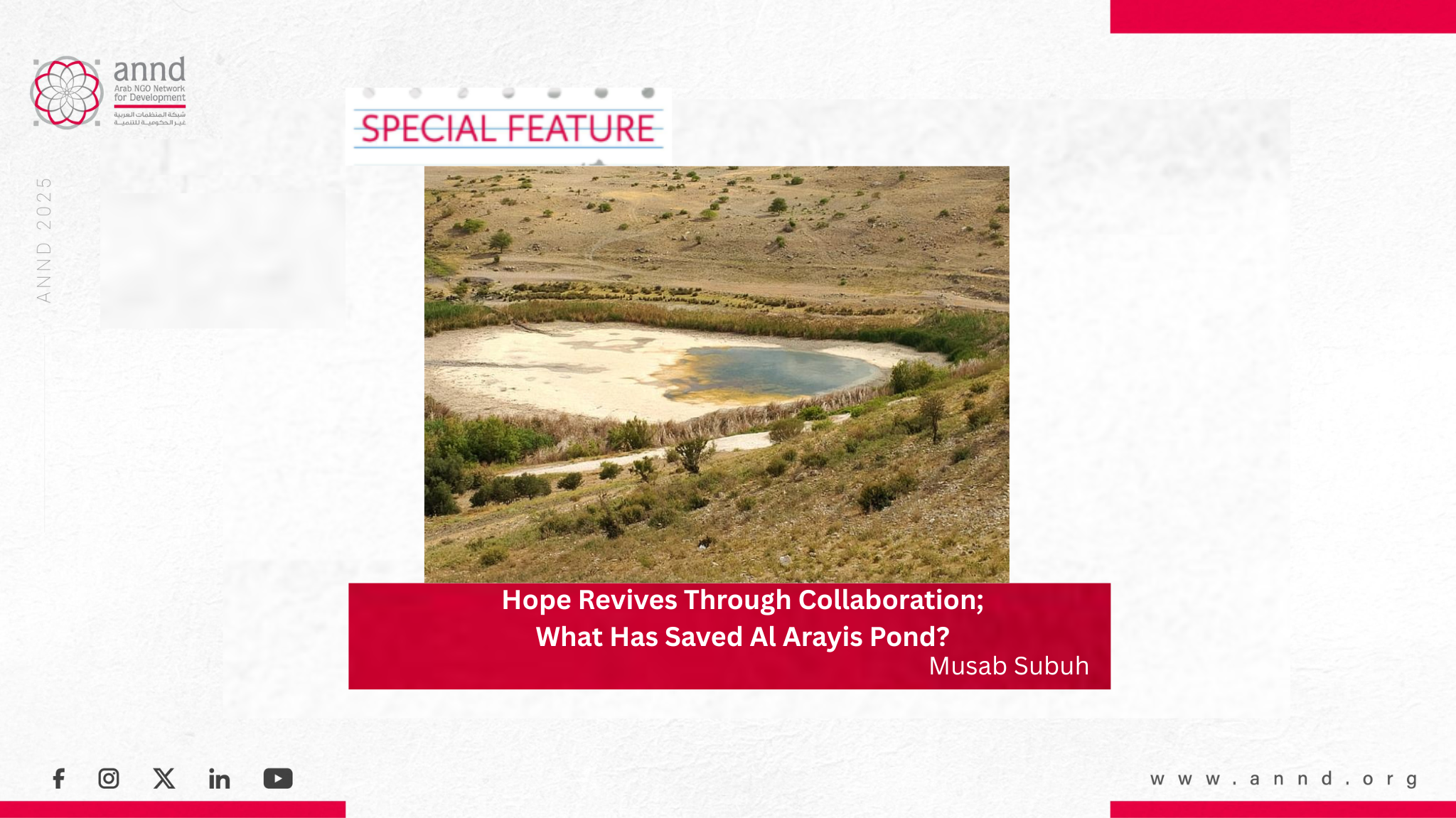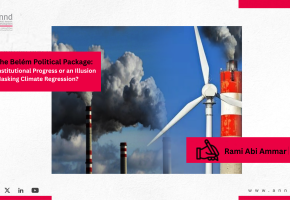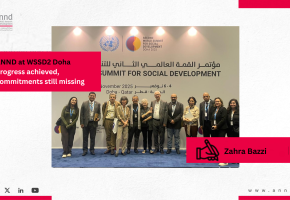
Hope Revives Through Collaboration; What Has Saved Al Arayis Pond? - Musab Subuh

Hope Revives Through Collaboration; What Has Saved Al Arayis Pond? - Musab Subuh
The
severe impacts of climate
change have only
intensified in recent years in Jordan
and Syria, both of which remain highly vulnerable to the global threat. This
has resulted in the sudden and complete drying of Al Arayis Pond in Irbid, Jordan, and Mzaireeb Lake in Dera, Syria. As both water bodies
share the same fate and originate from the Yarmouk Basin, local communities and
official statements attribute the droughts primarily to past violations of
transboundary water arrangements. For them, the loss of these sites represents
not only an environmental tragedy but also the erosion of collective memory and
cultural heritage—an outcome perceived as man-made. But what has saved Al
Arayis Pond?
“My
heart, and the hearts of families around the pond, weep from this loss,” said
Mohammed Malkawi, Manager of the Yarmouk Forest Reserve at the RSCN, describing
the sudden drought of Al Arayis Pond as a result of over-extraction from the
Yarmouk Basin.
Similarly, “Mzaireeb Lake has completely dried
out,” said Obaida
Hitti, who explained that he was forced
to abandon farming due to the drought. He pointed to the spread of “illegal
wells that cannot be controlled” as the main cause of the drought.
Al
Arayis Pond, located in Irbid in northern Jordan, lies near the transboundary
Yarmouk River and is fed by the Yarmouk Basin. Mzaireeb Lake, on the other side
of the border, is situated in Dera, southern Syria. Both surface water bodies
share the same source: the Yarmouk Basin, and the same fate of drought as a
transboundary resource.
“Yarmouk Aquifer has reached its
lowest points and now is depleted” said Hisham Al-Hisa, Secretary General of Jordan Valley
Authority, resulting in droughts of surface waters
in Jordan and Syria. As ‘both
countries are facing severe climate challenges’, Al Hisa said; “It motivates us
to collaborate more on transboundary waters to face these challenges”.
Following field visits across Jordan
and collaboration with Syrian colleagues from the Blue Peace Middle East Junior
Media Hub, who have also visited sites in Syria, I investigated shared climate
challenges, explored comprehensive solutions and opportunities for water
diplomacy and collaboration, and documented stories of water resilience.
Blue Peace Middle East, an initiative
chaired by HRH Prince El Hassan Bin Talal, is the first regionally owned
initiative that brings together senior water experts, politicians, academics,
and media professionals, among others from the Middle East, to strengthen
collaborations over water that transcends borders, sectors, and generations,
dedicated to improving the region’s water, food and energy security and
preserving ecosystems in a changing climate.
Governed by a Regional Mechanism, with
members in Iraq, Jordan, Lebanon, and Türkiye, and a geographical reach
extending to Iran and Syria, Blue Peace ME uses dialogue, capacity building and
concrete actions to realize its mission to transform water from a potential
source of conflict into an instrument for cooperation in the region.
While
investigating the climate and water challenges that the national Maloul
Tree has been facing, I found ‘shocking images of sudden droughts’ of two
surface water bodies sourced from the transboundary waters; Yarmouk Basin,
Al Arayis Pond in Irbid
North of Jordan,
and Mzaireeb Lake in Dera South of Syria.
Hisham Al-Hisa, Secretary General of
Jordan Valley Authority, and Co-chairman of The Jordanian-Syrian Joint
Technical Committee between Jordan and Syria, referred to ‘the sudden droughts
of the water bodies’ as a result of ‘previous violations on transboundary
waters that have depleted the Basin over decades’, and to be matched this year
with ‘severe drought and climate change impacts.
Al-Hisa said;
"Violations of the past regime in Syria on the Yarmouk River, source
of the Basin were countless, and the main reason for the drought of Al Arayis
and Mzaireeb is the depletion of the Yarmouk Basin over decades. This is to be
added to the severe climate impacts that we are suffering from; drought,
fluctuation of rainfall, rise in heat. Regional wars and conflicts, manufacturing
and industries, refugee problems, and the rapid growth in population only
worsen these impacts. Therefore, the most water scarce in the world, Jordan, is
among the most vulnerable countries to climate change, and among the least
contributors to it”.
Shared Challenges; Severe
Drought
In reference to the shared challenges
Al-Hisa said, “We are looking at severe drought and climate impacts affecting
Syria and Jordan as regional and shared challenges”, adding that “this is one
of the main motives to strengthen collaboration over shared water resources as
we are facing a common threat”.
I checked the latest status of Al
Arayis Pond, close to Yarmouk River. Mohammed Malkawi, Manager of Yarmouk
Forest Reserve by the Royal Society for Conserving Nature RSCN, said, “The Pond
completely dried out in 4 months, no climate impacts would do that alone, it
has to be a man-made violation”.
Malkawi couldn’t hide his grief,
adding that, “this would only worsen the severe challenges of drought we have
this year”.
“We have drought this year, only 221
mm of rain, just one-third of last year’s total. We are the most water scarce
country in the world, but no one could imagine the impact of
over-extracting and losing a precious surface water body” he said.
As Malkawi communicated the loss as in
natural, national, and cultural heritage, he described the drought in
communities around the pond to be worsened. He said, “There is a spiritual
connection between people here and the pond” explaining that brides would come
to the pond ‘to be blessed’ by its water as traditional wedding ceremonies.
“For generations we have been visiting
the pond to find peace, to enjoy its unique nature, to honor our brides, today
we’ve lost a part of our cultural
heritage” said Malkawi
expressing his weep after the pond,
and the effects on the collective wellbeing of the local communities around it.
He added;
“This drought will heavily affect
resilience and awareness programs we run to empower around 40 households,
training them on recycling and sustainability, giving a chance for traditional handcrafts from Halfa trees, and
raising awareness of Water-Energy-Food-Ecosystem WEFE, as the Royal Society for
Conserving Nature RSCN is all about helping nature, helping people. We have
seen worse, however with collaboration with local communities, and securing our
water resources we could survive”.
Yousef Al Shammari, 60 years old and
Head of Beni Kinana Foundation for Conserving Nature, said:
“I know families close to Al Bajja spring (a spring sourced from Yarmouk Basin same as Al Arayis spring), water couldn’t
reach them for almost 2 months now. These people cannot afford bread that costs
1 JOD, how could they afford 5-25 JOD of water tankers?!”
Yarmouk River and Basin are considered
among main water resources for Jordan and Syria. Some residents in Amman, found
themselves ‘in an urge to pay an additional 25 JOD per water tanker
for the first time since 2017
for water tankers’ according to a resident who lives in East Amman.
“We have a 60% increase in requests
for water tankers this summer,” said a water tanker driver, who requested
anonymity. “It was taking us one hour to fill 5-6 cubic meters from the well
last year, now it is taking around
4-5 hours to fill the same amount,
due to weakness in water
pressure”.
People around Mzaireeb Lake joined in grief people
around Al Arayis
Pond, as the people
of both countries, Jordan and
Syria, share challenges of drought this year.
Obaida Hitti, 28 years old, a resident
of Dera, said; “Mzaireeb Lake was a strategic water resource, important for eco-tourism, distributing water to many districts including Al-Suwayda” adding that “Now
people around the lake are facing an existential threat and thirst after the
lake is gone”.
Hitti
used to be a farmer
around Mzaireeb Lake.
He said “I can’t
farm anymore due to the drought of the
lake and there is no water anymore”. Hitti, refers to “over-extraction of the basin
by thousands of illegal
wells, it is unfair that they can’t
stop some rich beneficiaries, or deter farmers
from illegally extracting more water from the basin”.
Thirsty Yet Resilient
Mohammed Siyam, 37 years old, founder
of Senara start-up and resident of Gaza Palestinian Refugee Camp, described the
impacts of the drought and the thirst in Jerash. “This year is very hard, there
are many springs, waterfalls, and surface waters have completely dried out,” he
said.
Siyam
said;
“Usually, water would come to
households from the tap every 10-14 days, during summer times usually, now it
is arriving from the authorities’ pipelines once every 21-30 days in some areas
around Jerash, people cannot afford the cost. Everyone is suffering now, farmers who used to rely on the rainfall are
no longer able to farm, they have to get water tankers to irrigate their crops.
The cost of one kilo Bamia (a plant of a traditional dish usually grown by rainfall water) for example will be 4-5 times higher”.
Siyam, who holds two university
degrees, explained how and why he turned into hydroponic agriculture, he said;
“I couldn't find a job, so I wanted to
create one to benefit young people around me as well. I learned about
hydroponics, and found that it saves at least 70% of water and can produce around 6 times more,
with less cost and healthier food. I adopted the method to be more resilient
against water scarcity”.
Siyam said “Words of His Majesty King
Abddallah II, on food sovereignty and security, have motivated me, and I was
supported by the Royal Scientific Society, UNDP, and Oxfam later on”. Siyam has
turned a small permaculture project he started on the rooftop of his home at
Gaza Palestinian Refugee Camp into a startup that supports around 13 local
farmers of hypotonic agriculture.
“In Jordan, we are remarkably
successful in resilience and adaptation against severe drought impacts, we
always find solutions despite huge challenges around us,” said Siyam.
He was recognized by His Royal Highness Prince El Hassan Bin Talal in June for Sennara’s
success in innovation and
resilience.
“I couldn't predict how motivated and
excited I would be when HRH asked the gathering ‘where is the artist behind
Sennara’, I felt supported. It was a turning point
for me and for our work in Sennara,”
said Siyam.
Rain
Harvesting and Grey Water
Sumayya Al Momani, 43 years old, Head
of Om Al Lolo Women Cooperative Society, told me her story of resilience
against water scarcity. She leads a cooperative to empower women of recyclable
and traditional hand crafts.
She started, in 2014, with the support
of her husband Qassem Al Momani, and the Royal Society for Science, to build a
tanker for rain harvesting, separating and treating grey water in another
tanker.
Sakhra, where the Al Momani family
lives, is a small village in Al-Junaid district in Ajloun, 60 km to the south
of Al Arayis Pond. Its population does not have any access to the water
network, and so they rely on rainwater.
The Al Momani family has provided
around 600 families in the region with the local and simple yet innovative
techniques they’ve put together since 2014.
“It has all started with the decision
to treat grey water waste, (washing, dishwashing, home daily used non-sewage
water waste) from black water (sewage water waste) and recycling it, using
natural and local materials”, she said.
“Water here is precious” said Qasem Al Momani, explaining the benefits of the system
on location; “the rainwater and the recycled grey
water come to the farm through the system in a closed circle of no- waste of any water,
no need for extra”. They’ve
started using solar
panels to generate
renewable energy to reduce
carbon footprint further.
Referring to the climate
challenges, and much less rain waters they rely on this year, Qasem said: “Over
the last few years, we started to buy water once or twice in summers, but this
summer, and until now only we have bought water 4 times
(estimated 100 JOD cost)”, he referred to around 250 JOD in cost as estimated to be this summer.
From Logging to
Guarding
Heavily affected by the total drought
of Al Arayis Pond, Abo Kamal, told his story of how he has turned into
protecting and advocating for Maloul Tree, a ‘grandmother oak tree’, announced
by Royal Recognition in 2002 as a National Tree of Jordan.
‘Symbol of resilience’, the Maloul
Tree is an endangered oak tree species.” Around two million trees exist around
the Yarmouk, in northern and central Jordan,” said Mohammed Malkawifrom the
RSCN. Efforts have focused on conserving, rehabilitating, and planting Maloul
Trees. However, it is now threatened by the drought.
The Yarmouk Forests Reserve
was established with the help and collaboration of the local
communities in 2010. The
Royal Society for Conserving Nature RSCN has established the reserve to protect
Yarmouk Forests, the main host of Maloul Tree.
Aged between 700 to several thousand
years, Maloul is one of the most precious heritages in Jordan’s nature, and
under threat of extinction.
Supported by Malkawi, the Reserve and
the RSCN, Abo Kamal started to believe in the interconnectedness
of Water-Energy-Food-Ecosystem, people, nature, trees and biodiversity.
“If we protect trees, it gives us
oxygen and cleans the air. If we protect nature and biodiversity, our
environment becomes better to farm, so we protect ourselves and future
generations” Abo Kamal said.
Perhaps that was what got him excited to show us his farm house, that
he’s made completely by recyclable
materials, as he explained how that would save energy and the environment,
reducing his carbon footprint.
Abo Kamal was one of Maloul Tree
illegal loggers when he was much younger; however, Mohammed Malkawi and teams
of RSCN in the Reserve have convinced him, around 15 years ago, to consider an
alternative and to ‘save rights of generations to experience this old cultural
heritage’.
Since the announcement of Yarmouk
Forests as a Reserve, Yousef Al Shammari and Mohammed Malkawi said there are
species that were believed extinct that have come back to be seen, indicating
the success of protection of the habitat, and the relentless efforts of the
RSCN to conserve nature, protect environment, and collaboration with local
communities on WEFE Nexus.
‘A hope in a hopeless place’
Azraq and Yarmouk Aquifers share the
same deprivation of transboundary water resources. Considered some of the main
water resources in Jordan, both aquifers are filled by seasonal water routes,
Yarmouk River, descending from Syria to Jordan.
People of Azraq, remember how in 1992
Azraq Aquifer has reached its lowest level, and the Oasis has irreversibly
dried out. No one could get back the 4 springs sourced from Azraq Aquifer that
were naturally restoring the balance of the water regime. However, the
relentless efforts of RSCN, the Azraq Wetlands Reserve have brought back hope.
Jordan was the first Arab country to
sign the International Ramsar Convention for Conserving Wetlands to protect
Azraq and conserve the Aquifer, in 1977.
With
implementation of the convention,
2 springs were simulated and established, in efforts to restore a minimum permanent percentage of the
aquifer, and the natural water regime of the oasis that could sustain the
biodiversity in the region, according to Mr. Hazem Hreishah Manager of Azraq
Wetlands Reserve by the RSCN.
Azraq was recognized as a World
Heritage Site by UNESCO. Now 10 million cubic meters a year are to be pumped
into the Oasis by the Water and Irrigation Ministry, permanently maintaining
10% of the Oasis as minimum, Hreishah indicates.
Hreishah said, “Azraq Sirhani Kili
Fish, is a hope in hopeless place” adding that “the only endemic fish species
thought to be extinct after the drought of the oasis, however when our
scientists found 3-4 pairs of the fish and started a scientific program to
restore its population the whole ecosystem started to thrive around the
wetland”
What happened in Azraq in the early
1990s of ‘over-extraction of water and deprivation of transboundary waters’,
is being repeated
in Al Arayis Pond, Mzaireeb
Lake. Local communities on both sides of the border are calling for similar
measures to restore these surface water bodies.
Empathy
May Strengthen Collaboration
Dr.
Dureid Mahasneh, is a pioneer awarded scientist of WEFE Nexus in Jordan,
referred to ‘empathy’, and collaboration over water resources as ‘a vital
element to face shared challenges’. He connected science, human feelings,
values, and diplomacy through water.
“It is the smart and the human way, we have
advanced irrigation systems, agricultural sustainable methodologies and
technologies, renewable energy systems, we can share the know-how with Syrian
brothers for a fair share of water from transboundary resources. The Syrians
seem to want to learn, so we can collaborate providing our experience. Empathy
between countries has to be the case especially when we share challenges in
transboundary waters”.
“You are looking at shared waters
between Türkiye, Syria, Iraq, you see a lot of disputes there. In particular it is also related to how political relations are” he said,
adding, “however we should look at
shared waters from a human rights perspective, your right, your neighbors
right”.
Valuing
unity and collaboration, Dr. Duraid gave an example of the Danube River, the
second longest in Europe, shared by ten countries, as ‘there is no dispute in
shared water resources. Why don’t we learn from that collaboration in our
region?” he wondered.
This
brings to mind our built-in
culture of our region, collaborations on Euphrates, Tigris,
Jordan, and Nile rivers that civilizations of
humanity had collaborated through thousands of years before the history of Europe.
Challenges Turned into Changes; ‘Very Positive Atmosphere’
As
wildfires have destroyed more than 3% of the wildlife in Lathqiya Syria,
lately, Jordan was one of the first countries to engage for help, with military
reinforcements to fight the wildfires.
This
has been considered as an indication of the good will from Jordan’s side to
help and collaborate in fighting the shared challenges in the season of
‘unprecedented heat and drought’.
Perhaps
this has led to ‘change into more understanding’ between Syria and Jordan ‘to
boost collaborations, reduce illegal wells on transboundary waters, and provide
Jordan with more water’ according to statements.
Hisham Al-Hisa,
referred to the latest collaboration momentum over water
diplomacy between Jordan and Syria, which happened in the
time of conducting this research, as both face ‘huge challenges of drought’, as
‘a very positive atmosphere’.
He
said:
“Lately, and over these shared challenges, we made many bilateral visits to
different points on Yarmouk Basin and River. H.E. The Water and Irrigation
Minister, Raed Abu Soud, has met several times with his Syrian counterpart H.E.
Minister of Energy and Natural Resources, Mohammed Al-Bashir. The Committee of
Syrian-Jordan Bilateral Water Relations established talks, and agreed on
strengthening collaborations on transboundary water, to develop and sustain the
Basin. We started talks to adopt collaborative projects of sustainable
agriculture, energy, and rain making projects. There will be a second round of
meetings soon, God's will. The atmosphere is very positive, and promising of
more collaboration and understanding. We agreed on the most important axis in
the talks; just and fair share of the transboundary water resources; Yarmouk
Basin and Yarmouk River, between Jordan and Syria”.
Resilience Converts
the Crisis into Collaboration
The
vision of HRH Prince El Hassan Bin Talal on Water Diplomacy—emphasizing the
need to convert water from a source of crisis into an instrument of peace and
collaboration—has been a key inspiration for resilience, progress in water
management, and advancements in the WEFE Nexus in the country.
“Thanks to the Royal Visions we have
in Economic Modernization, WEFE Nexus, and Water Diplomacy, Jordan has been internationally recognized for success
and resilience in water management, agriculture and food production, despite the challenges” Hisham
Al Hisa said.
“We
have adopted these visions to be part of our strategy (2024-2026) at the Water and Irrigation Ministry and the Jordan Valley
Authority” said Al-Hisa, and added;
“This is an important access
in the bilateral relations between Syria and Jordan, especially the possibility of producing
renewable clean energy in return of water shared with Syrian brothers. This has
been a strong foundation now on the table of collaboration and bilateral talks and will be followed by executive plans
soon”.
Al-Hisa considered the resilience and success of Jordan, as ‘one of
the most important elements in the talk with Syrians
that’s
been converted to collaboration opportunities’ and as ‘inspired by
HRH Prince El-Hassan’s Vision’. As the crisis of droughts and climate change impacts have been
affecting Jordan and Syria, the shared challenges are being converted
into empathy, diplomacy, and chances to collaborate to face the thirst.
Al Arayis
Pond Is Being Saved
During the time of conducting this in-depth article, Jordan Valley Authority started to pump water into the
pond, in response to local communities
calls, to save rare and endangered
species, the biodiversity around the pond. Hisham Al-Hisa, said “we have responded by creating a channel to
pump water into the pond to save the biodiversity”, adding that “at the same time our meetings with Syrian
brothers are moving forward to more collaboration, already started planning
rainmaking joint projects”.
Meanwhile UNESCO officially recognized Yarmouk Forest Reserve and Ajloun City on the list of Jordan’s National Natural Heritage. Concludes that diplomacy, motivational care about natural water resources, and collaboration on transboundary waters only provide hope for next generations, and a future that is more resilient.
Recent publications

The Belém Political Package: Institutional Progress or an Illusion Masking Climate Regression? - Rami Abi Ammar
